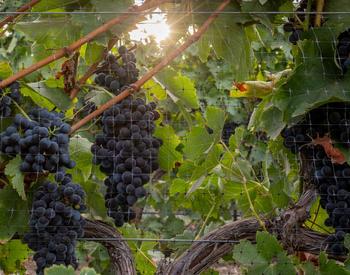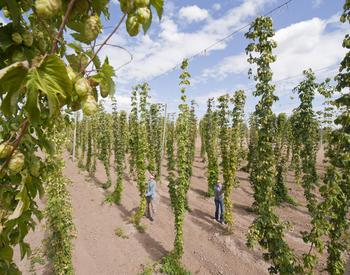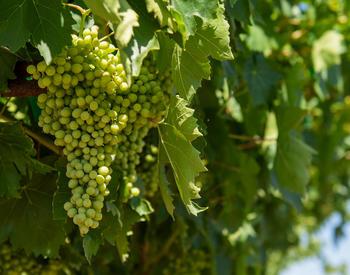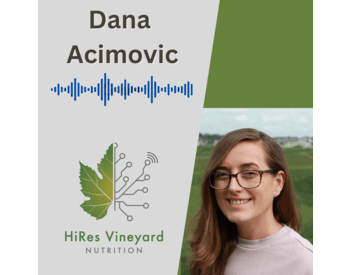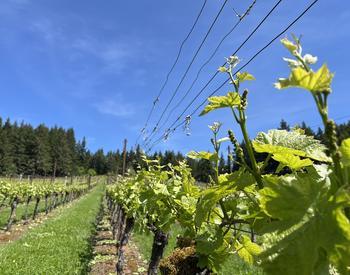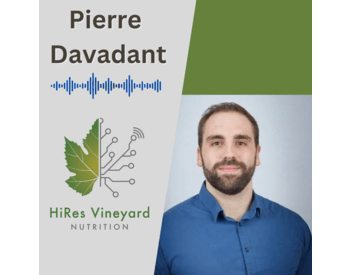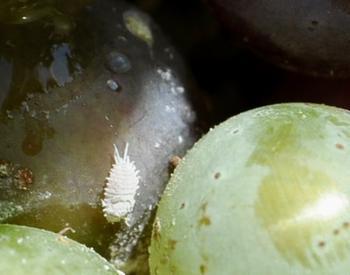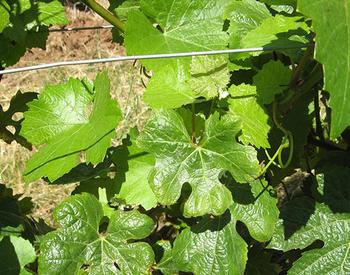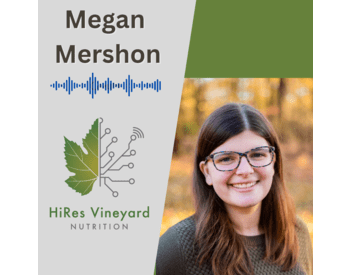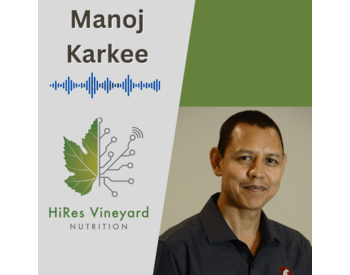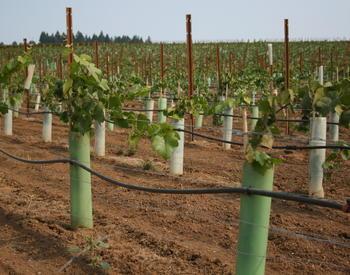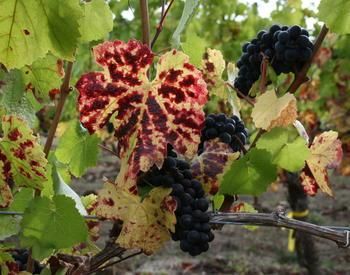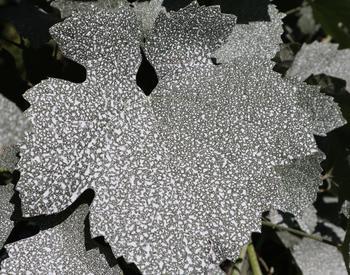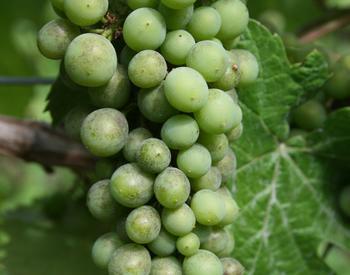Transcript
(00) Patty Skinkis
This is the High-Res Vineyard Nutrition Podcast, devoted to helping the grape and wine industry understand more about how to monitor and manage vineyard health through grapevine nutrition research. I am your host, Dr. Patty Skinkis, Professor and Viticulture Extension Specialist at Oregon State University.
(00:23) Patty Skinkis
Vineyard management requires a lot of decision making as viticulturists and growers cannot follow a simple or easy crop production plan year in and year out. There are many decision points that occur throughout a day, a week or a season. Weather, vineyard variability and other components of the vineyard system are concerns for vineyard management. Often our goal is to achieve optimum uniformity and improve production, whether that’s quality or quantity of our products while also reducing costs. This is a big task, and luckily some researchers have taken on this goal to understand the whole system to help growers make more informed decisions, and the goal of the High-Res Vineyard Nutrition Project is just that – to figure out how to best manage our vineyard nutrients and possibly reduce inputs or maximize or optimize our inputs.
One of our project directors, Dr. Terry Bates, brings with him experience in Precision Agriculture applications through the Efficient Vineyard Project, which sets out to help growers make decisions. So, today with us we have Dr. Terry Bates. He is the Senior Research Associate and Director of the Cornell Lake Erie Research and Extension Lab at Cornell Agri Tech. He is well known for his research and its direct application for grape growers in New York, the northeastern United States and beyond. He readily shares results of his work with other viticulturists in the region and nationally. While he is well known for his Efficient Vineyard Project to help integrate precision agriculture into everyday farming for growers, he had his start in root biology and horticulture. He has a PhD in plant physiology and a Master’s of horticulture from Penn State University. He was once a National Science Foundation Root Biology Fellow as a doctoral student and spent his time working on root physiology for his PhD dissertation, then not with grapevines. He was working with Arabidopsis. However, he’s now very well known in the viticulture world for both his research and his extension, gaining him the Extension Distinction Award in 2014 from the American Society for Enology and Viticulture, amongst other awards. So, we’re pleased to have Terry with us today.
(02:40) Terry Bates
Thanks, Patty. I’m really happy to be on the podcast and excited about this whole project in general.
(02:46) Patty Skinkis
Thank you for joining us. I think the Efficient Vineyard Project and marrying that with this High-Res Vineyard Nutrition Project is going to be kind of the icing on the cake, at least in the next steps of doing research that really puts precision agriculture in the hands of growers. I wanted to ask a few questions of you regarding the Efficient Vineyard Project. We know it was a successfully funded federal project that aimed to tackle many areas of vineyard management using tools of precision agriculture. What were the biggest outcomes or outputs or learning lessons that you have from this project?
(03:25) Terry Bates
You’re just going to start off with a really loaded question! The Efficient Vineyard Project as we call it now, the real title is “Precision Vineyard Management: Collecting and Interpreting Spatial Data for Variable Vineyard Management.” So, this is kind of our first go in the grape industry of having a large specialty crop research initiative project which is supposed to be multi-state, multidisciplinary and involve the grape industry across the United States. So, you put all that all together and there was just a lot of talent and knowledge and ideas out there, so you can very easily get into like a scope-creep kind of thing. Our project really tried to stay focused on crop load management. We wanted to know more about crop size and estimating crop size and then maybe understanding the measurement of crop at the end of the season. We were looking at sensors to help us do crop size. Then also some indicator of vineyard health, so vine size, canopy fill, vine capacity, whatever term you want to use. We were using sensors to do that as well. So again, the whole thing about that project was to stay focused on what sensors were available or needed to be developed to measure soil, canopy and crop characteristics in vineyards, validate those sensors with in-field measurements, and then apply variable-rate mechanized management for, again, crop load, balance and fruit quality. So, we did all that. I would say the major lesson learned out of all that was really: A) That it’s possible; that there is a method for doing it, and it is worth it. What I mean by those is: Is it is possible? One of the things that we were worried about at the beginning, it was, this project was very exploratory. It was--are the sensors out there? Is the technology developed enough for us to be able to use it in vineyards? Where were the shortcomings where we had to engage engineers in developing new sensors? I think the first outcome is that it’s possible, right? The sensor technology is there. It's accessible to growers now and is being used and can be used for anyone who wants to get involved. Second, there’s a method. If you go about precision viticulture in a haphazard way, you’re going to get haphazard results. There’s somewhat of a method, right? You collect spatial data, you validate and translate that data into something that you can use in viticulture. A good example is, how do you translate an NDVI map into a pruning weight map? So, we have engaged precision ag specialists into the world of precision viticulture to help us with that whole method. Then is it worth it? I think that was one of the, I always see myself as an end user --is the technology worth it if I understand the variation in my vineyard, I can map it and then I can respond to it with variable-rate management. Is it worth it? I think the third take-home from that project is yes. If you have a problem you’ve identified and you address it with that sensor data and then apply variable-rate management, we’ve seen example after example of how it improves either yield or quality or whatever it is that the vineyard manager is going after.
(07:08) Patty Skinkis
I love that description of the project. Really succinct and hitting the high points about the ability to use these tools. I think so many people are afraid to even delve into precision agriculture because it looks scary. They don’t know the technology or they think it’s going to be too expensive. I particularly like your comment about if you use precision ag tools haphazardly, you’ll get haphazard data and I think that’s also a downfall is that perhaps that’s the way it’s been used. The new ticket or key, ticket item that everybody wants to get their hands on but not necessarily using it to the best of that’s ability within either a suite or that method. So, you described the method.
Can you tell me a little bit more about the method and how that works and how some of those methods might be moving into the HiRes Vineyard Nutrition Project?
(08:07) Terry Bates
What we really want in the future is a sensor that gives us an absolute measurement of something viticulture in the field. I would love to have a sensor that just goes out and tells me what the yield is. Right now, I don’t have a sensor that just tells me directly what the yield is; all the sensors are indirect measurements. I’m either getting a visible berry count or I’m getting off of a yield monitor, whether it’s a load cell or impact plate. I’m getting some kind of signal off that fruit coming off the belt, we’re translating that into a yield, and we have to calibrate or validate any sensor that you use. So that’s really the first part of the process. I have a sensor measurement—it’s an electronic signal of some sort. We need to translate that into a viticulture measurement. We do that by in-field measurements, and we try to make that as efficient as possible. So, you can’t just go out blindly in your field and just, as engineers always tell me, we need to take 100 times more measurements in the field to validate our sensors than what we’re actually taking, so we’re trying to get the most out of our sampling protocol. Our process is to analyze the spatial data, break it up into statistically different zones, and then be able to stratify our samples against those zones. Then we look for relationships between our in-field sampling and what the sensor is giving us. If we get a nice, positive relationship, we can then translate our high-density sensor map into a high-density viticulture map. So, I’m going to manage my vineyard off of crop size or vine size. I’m not going to manage it off of NDVI because NDVI really doesn’t make sense to me. But, if I know I have on one end of the vineyard in two tons per acre on the other end of the vineyard, that makes a lot of sense to me on how I’m going to go about managing that vineyard.
(10:09) Patty Skinkis
Excellent. I like that analogy, using those hard numbers that everybody understands. They know and they usually can see the difference in their field.
(10:17) Terry Bates
It’s one of the biggest downfalls that everybody just wants to take the sensor data and just use it. There is a bit of hard work involved. You have to walk out to the field, and you have to collect some kind of observation, whether that’s a measurement or even just a visual observation of where you are in that field and how the vines are responding to your map.
(10:37) Patty Skinkis
Well, that’s a good sign that humans aren’t obsolete just yet. So, there’s certainly components of the Efficient Vineyard Project that are being moved into the [HiRes Vineyard Nutrition] project. Can you speak a little bit about those things are that you decided to take forward, or is it the whole suite?
(10:56) Terry Bates
“All of it” was going to be my answer. It’s all of it. I love this project because it builds on everything that we’ve already known. It builds on the mistakes that we’ve made; it’s building on the success that we had in the project. Again, the whole process: measure, model, manage. In this project we are coming up with new nutrient sensors for the “measure” part. Then again, we’re using hyperspectral imaging, and that’s going to give us a signal, and the engineers that are very talented are going to tell us what wavebands or waveband combinations are going to say, relate to nitrogen or potassium so that we can translate those hyperspectral, spatial hyperspectral maps into a spatial-nitrogen map, or a spatial-potassium map in the vineyard. So that whole process, again, they collect the sensor data. We do the in-field experimentation and sampling to validate their sensor measurements, and then be able to generate those spatial viticulture maps, or spatial nutrient maps, in this case.
(12:06) Patty Skinkis
The researchers that are involved (the engineers), the sensors they are using are research grade, correct?
(12:12) Terry Bates
Yes, in our particular case here at the Cornell Lake Erie Research and Extension Lab, we are working with the imaging scientists at Rochester Institute of Technology, and they fly drones over our research fields where we are trying to induce different nutrient deficiencies to match up with their imaging and their sensors are, I mean I think we just throw out the number, there’s about $150,000 worth of sensing equipment on these drones, and no grower that I know of is going to spend that kind of money to fly over their vineyard. So, the idea is to use this very expensive, high-tech scientific instrumentation to develop a robust, low-cost, in-field sensor that is accessible to the grower community. Again, we did a very similar thing in the earlier SCRI [funded] Efficient Vineyard Project with Carnegie Mellon and their imaging technology where they used some high-tech, very expensive technology to come up with image acquisition and berry counting, and then they had to distill that all down into a rugged, field-ready unit that’s now been commercialized through Bloomfield as a unit that you can run through a vineyard and it’ll automatically take those images and stitch them and identify what’s in pictures and count them and just give you a spatial map of say, visible berry count.
(13:41) Patty Skinkis
Excellent. So, what types of decision support tools are available to specialty crop growers such as grape producers or even others? And with the decision support tools, this might be sensors but they also might be programs (apps or software). Are there any available that people can use?
(13:59) Terry Bates
Yeah, so, we developed this, we call it the “My EV Platform.” So, we saw from the earlier project a big hurdle for growers to get involved with precision agriculture, or more specifically dealing with spatial data--the idea of having to learn ARCGIS or some of these very powerful software programs for just visualizing the spatial data in the field. So, through the project we started to develop an open-source, web-based platform. I keep telling people, I call it the “Instagram of precision viticulture.” You have Photoshop which is a very powerful image processing software for professional photographers, and most people on Instagram just want to upload a photo, apply a filter and be able to make themselves look good, and this is very similar. Those powerful precision ag or spatial data processing software ARCGIS, all that high-end software, what we wanted to do was address what a vineyard manager really needs. What are the five functions that they really need--to upload, process, translate what we’ve already talked about. Translate spatial data in viticulture data and to be able to use that to generate prescription management maps. So, that’s what we’ve done. We’ve distilled it down into one package, and it’s open and available for any grower that wants to use it.
(15:39) Patty Skinkis
Do you have any growers that are currently using?
(15:44) Terry Bates
Yes, I can look at an administrator view of My EV and see where all the locations are around the world that people have started using it. So, we are in almost any area that is a major grape production region around the world, somebody is using My EV to build their farm, upload spatial data to their vineyard blocks, and process it and visualize it. I think our highest usage is here in New York because we’re engaged with this local industry but also in California. I think some of our most active users are in California.
(16:24) Patty Skinkis
So, when they’re using the platform, do [users] get to choose the inputs? Is it data that they collect or do they have certain sensors that they can choose how they’re putting data in?
(16:41) Terry Bates
Yes, we built the platform so it will accept any data with a latitude-longitude coordinate. So, that can come from sensors. We also have a cell phone app where somebody can go out and collect their own observations in the field and it follows you along in the field your geo-location, so you can just make observations in the field and upload that spatial data so you can be the sensor. There’s a plug-in patch and I know a lot of people have NDVI fly-overs that are raster images and there’s a raster conversion tool within that. So, if you have a raster NDVI image, you can turn that into point data. My EV works off of point data, so we really just tried to build it so that growers can import any kind of spatial data that is in their vineyard.
(17:37) Patty Skinkis
That’s great. I think we need to get more people using it or at least trying it, especially with a free program. So, what do you think researchers or Extension specialists can do to improve adoption of precision agriculture?
(17:55) Terry Bates
So, I read a study recently, and I was trying to look up the reference before we jumped online here, that talked about return on investment for precision agriculture. The opening statement was something like 60% of all people who get into precision agriculture don’t see a return on investment, and they gave some reasons why. I think I totally agree with what this report said, and I think as researchers and Extension specialists we can address them. So, the three are: education, or lack of education of the decision-maker in the business. So, you may have a vineyard manager who’s like “Yeah, I love this Precision Ag stuff and it’s really good,” but if the winery owner isn’t really engaged and educated on what the possibilities are or you know the benefits of precision viticulture, then it doesn’t really take off. The second one was at-scale investment, and if you’re a very large wine company, you probably have already hired somebody to do your precision viticulture work-- your GIS – they’re trained in GIS. But, there’s a lot of small farmers out there, small grape growers, wineries or even just farms who aren’t ready to put the big dollar investment in both sensors or people that have been trained in this area. So, the at-scale investment thing is very important, and that’s where the My EV platform falls into it, where, hey, you just want to get started, here’s a free, open-source platform for you to get started. So, that’s where we’re hoping that growers would get started and then graduate up to the more powerful software once they understand what’s going on. The third one was another real important one, is a business purpose for the technology. So, lots of people just jump on because, “Oh, sensors are cool and I get to fly a drone over my vineyard,” but without a business purpose, it kind of lands flat. I like the idea even when we went back to the other SCRI project or with this project on nutrition, we’re after a very specific business purpose. I want to know what the pattern of nitrogen is in my vines, in my field, and that is going to directly inform and influence my nitrogen management plan. You know, variable-rate nitrogen applications within the field to achieve whatever it is that you want. Like, if you want vine balance, or if you want to increase your yield, or if you want to be able to control canopy growth in yield through your fertilizer management program. So, I think those are the big three things: education of the decision maker, at-scale investment, and the business purpose of the technology. You put those three together, and I think you’re going to see more people adopting the technology.
(20:52) Patty Skinkis
I think that’s a great summarization of the work we have to do in the project, and in trying to keep our eye towards the development of something useful to industry. With High-Resolution Vineyard Nutrition Project we have a wide scope of expertise – both viticulturists, winemakers, engineers as well as economics folks who are working on the project that’ll keep the eye on the prize. I think specifically with this project the focus on nutrition is helpful from the standpoint of the fact that these are inputs we’re creating or doing in the system. They cost something; but sometimes it is not as easy to see the cost or the return on investment compared to a pest or disease management or water management situation, but we know nutrition is important, so I’m glad that we have you in the project and that we’re working towards these goals.
Now, can you tell us a little bit about the specific trials that you’re doing for the High-Res Vineyard Nutrition Project?
(22:01) Terry Bates
Yep, I have kind of two roles on this project. One is to support the sensor development: support the engineers by doing the viticulture field work. Then, the other one is in the application of variable-rate technology. So, I’ll tackle the first one. So, we have vineyards that we have set up on a small scale, so on a one-acre scale--we have sub-blocks where we’re inducing nitrogen deficiency and we’re inducing potassium deficiency. In our case in New York, we have very acid soils, so we have one sub-block that has acidic soils and there’s a complex of nutrient deficiencies in there like magnesium and phosphorus versus a very healthy check block. That is where the engineers come and they fly their hyperspectral images over and they collect that data, and then we sample. Within that block we will have 100 vines that we sample--individual vines--for petiole and leaf blade samples at both bloom and veraison and we have those analyzed for its nutrient content. Then we’re able to work with engineers on marrying their sensor technology with the in-field measurements. So, it’s kind of interesting because normally you take a vineyard block and you’ll do some kind of tissue sub-sampling across that block on a practical basis, and because we’re doing research you’re taking 50 leaves and petioles off of a single vine, having it analyzed is a little different than normal, plus you end up taking off a lot of leaves.
Then on the other side is more of how are you going to apply [nutrients] if we are able to develop a nitrogen sensor or a potassium sensor. I can get a map of a commercial-sized vineyard, or we have what we call a commercial-simulated vineyard, where we fly the same sensors with a drone over that vineyard. We give our best guess or our best estimate from the technology of a nitrogen map and a potassium map of that vineyard. Then we can do our stratified sampling of tissue across that vineyard to, again, validate or calibrate the sensor to that vineyard. Then I can make a management decision: I want to change my application rate of nitrogen going across that vineyard. So we do that [fertilize] by, at least in the East, we’ll use dry fertilizer application, and that goes to a fertilizer spreader that’s controlled by a hydraulic valve. If it’s controlled by hydraulic valve, we can make it variable rate. So, we have a prescription map that goes through a field computer that then controls the flow rate on that hydraulic valve, and then we can just dial that up into the map. The person working in the vineyard can drive up and down the rows and the fertilizer spreader does all the variable-rate action and they don’t even have to think about it.
(25:20) Patty Skinkis
That’s excellent. It’s certainly a little bit challenging to use that in a variable rate for a drip-irrigated vineyard. But even here in western Oregon we could probably use the spreader-type fertilizers, if it’s done at the right time of year while we’re getting rainfall. So, it’s neat to see that application being tested. So, the next question is a fun question: What do you think will be the greatest innovation in the US for US grape growers by the end of your career? So, this can be outside of the projects you’re involved with, but what do you think is going to be the biggest innovation?
(26:09) Terry Bates
Oh, that’s a great question, and I don’t have a pie-in-the-sky answer for you. I think the listeners would like me to say, “We are going to develop a sensor to do “X” and it’s going to be the best thing ever,” and I don’t think it’s going to happen that way. Precision viticulture is a multi-layer decision-making process. You’re going to integrate your soils maps with your canopy maps with your nutrient maps and your yield maps, and for the grower to make that decision. Second, every single operation that I’ve been involved with is different than every other operation really is very tailored to the particular winery and what kind of product that they’re trying to develop and at what price point. All of those decisions are a multi-layered decision-making process. I think the biggest innovation is going to be integration. To be able to have the tools and you can integrate them for your own business purposes and then put them into actionable items within your field. I’m just not a firm believer in the “Easy Button” where you’re just going to have this one great thing - it’s really going to be about integration. I think down the road the technology part of things is only going to keep getting better. We are already working on a separate project on robotic pruning. We are working with engineers at Carnegie Mellon University to develop a robotic pruner that we can train to do different pruning rules. So, the robot rolls up to the vine, it scans it, it can measure what the pruning weight is and what right number of buds are there. We can integrate that with last year’s information on, say, vine size or crop load and then have it actually prune the grapevine to our pruning rules. I think that kind of technology is way down the road, but I think we just have to keep embracing it, integrating it with our management decisions, and that’s going to be the big innovation is integration of the technology.
(28:28) Patty Skinkis
I like your answer because I’m very practical as well. So, a “pie-in-the-sky” description usually leads to a little bit of skepticism from researchers. I think the other big part is possibly going to be that information from the research is going to lead to perhaps even better technology down the road, even if the technology isn’t perfect, like you said. So, I think you’re right on, at least from a practical standpoint. But who knows what’s going to happen in the future. Even in the past several decades we’ve seen improvement of the information that’s available to grape growers.
(29:10) Terry Bates
I think the technology is really good. It’s interesting but I haven’t found anything to be perfect yet. Even when we have discussions with these engineers they’re like oh they want an R-square of 0.9 and I’m like you know an R-square of 0.6 pretty darn good, and I can use that in my management. So, they’re often looking for developing the technology to get a perfect relationship. I’m saying if I have six sensors that have somewhat of an imperfect relationship but they’re all the story is pointing me in the right direction, I can definitely integrate that into my management plan and make the vineyard better productivity-wise, quality-wise.
(29:54) Patty Skinkis
So, one last fun question. How did you decide to go from working on root physiology of Arabidopsis to viticulture? Do you have any suggestions for students who are studying applied versus fundamental sciences for their future career trajectory?
(30:10) Terry Bates
Yeah. When I applied for and was lucky enough to get the job with Cornell University working with the industry, the industry was looking for better information on vineyard nutrition and root growth, rootstocks, kind of pests that were attacking the root system. I did a bunch of work on that when I came up here. I looked at soil pH and rootstocks with Peter Cousins, and I quickly…this kind of talks to what advice I would have for young scientists. So, I took this job. The job was very much working with the industry, identifying what the industry’s needs were, and the industry was saying, “We need more nutrition work,” and they did, but we also have major labor issues. So, vineyard mechanization played a role in that. My program adapted to what the needs of the industry were. We started working on stuff like mechanical pruning, crop load management, and thinning in the middle of the season. Again, everything’s integrated: the vine health, nutrition and water relations related to vine growth, and how well you would go about pruning that grapevine and adjusting the crop. I was at a conference and I was talking about the work we were doing on crop estimation and thinning, and Stan Howell from Michigan State University said, “Yeah, but what happens when your crop size is different on one side of the vineyard than the other?” That really is what got me rolling down this area of precision viticulture. I’m like, how do I do a pre-emptive strike? How do I know how can I use sensors to know the crop is different on one side of the vineyard than the other so that I can make my management decision on variable-rate fruit thinning? Which is something we now have achieved and we routinely do it, so starting next week we’re thirty days after bloom. We’re going to do our crop estimate and if we have variable-rate yield going across the vineyard, we will probably do variable-rate fruit thinning to balance those vines going across the vineyard.
(32:27) Patty Skinkis
Great. So, Terry, I want to thank you for joining us today. Can you let us know where we can find more information about your Efficient Vineyard Project?
(32:36) Terry Bates
Go to https://www.efficientvineyard.com/. That’ll tell you about the old SCRI project that we completed and how that’s leading into these new projects like the HiRes Vineyard Nutrition Project. We have another project where we’re doing more development with My EV and we also have that robotic pruning project, so you can find that kind of information at efficientvineyard.com, which is also just going to take us to the High-Res Vineyard Nutrition website that you’ve built for us.
(33:06) Patty Skinkis
Well, thank you again, Terry. If you want more information on the High-Res Vineyard Nutrition project, feel free to visit our website, as Terry noted, it’s https://highresvineyardnutrition.com/.
Precision agriculture has been slow to make its way into vineyard production. The technologies seem too good to be true or out of reach for many growers. Dr. Terry Bates, Senior Research Associate and Director at Cornell AgriTech's Lake Erie Research and Extension Lab, describes his research to make precision tools accessible to growers, using the “measure, model, and manage” mantra.
